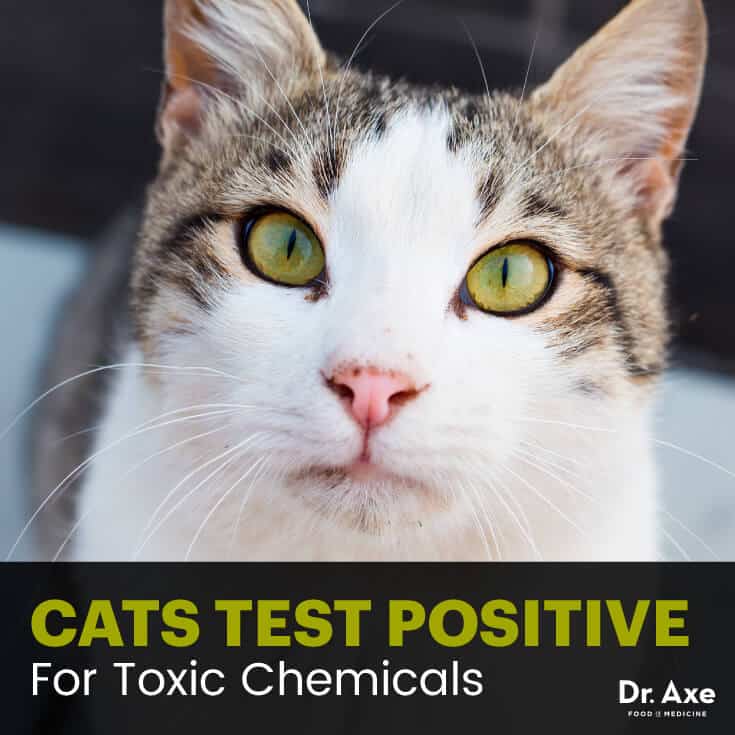
Turns out your favorite cuddle buddy is likely loaded with toxic chemicals. While cats may seem relatively safe inside the comfort of our homes, emerging research is detecting common chemicals in cats at mega-high doses, something that should serve as a warning sign for humans in the house, too.
Because cats living in the home are low to the ground and frequently lick themselves for grooming, they’re ground zero for household chemical contamination. Small children are in a similar boat because they crawl around on the floor and are notorious for putting things in their mouths. So what’s turning up inside of cats is also likely inside of us, and that’s not a good thing. Let’s take a look at the details.
Chemicals in Cats: Sofa Chemical Causing Thyroid Disease?
In 2017, Stockholm University researchers focused on one chemical culprit in particular: brominated flame retardants. Environmental Working Group named this class of compounds one of the top chemicals threatening your health. The study, published in Environmental Science & Technology, confirms what scientists previously suspected: Fire retardant chemicals are winding up in cats through household dust and causing health problems. This is the first time scientists have been able to verify this household threat in cats.
But where do these chemicals come from? And what happens when they wind up inside of our pets (and us)?
Manufacturers often add brominated flame retardants to fabrics, textiles, furniture foam and electronic equipment to prevent the material from igniting. Many brominated fire retardants are endocrine disruptors; some have even been banned, but they persist in the home (and your body) for a long time. (1)
“The brominated flame retardants that have been measured in cats are known endocrine disruptors. It’s particularly serious when small children ingest these substances because exposure during the development can have consequences later in life, such as thyroid disease.” — study author Jana Weiss, PhD, environmental science and analytical chemistry researcher at Stockholm University (2)
In a previous study, the researchers demonstrated that higher levels of brominated flame retardants turn up in cats with feline hyperthyroidism compared to healthy cats.
Other Chemicals in Cats
This isn’t the first study to detect chemical chaos in our cats. In 2008, Environmental Working Group published a report called “Polluted Pets.” It found 48 industrial chemicals in cats and dogs, including 43 chemicals at levels higher than those typically found in humans. This contamination comes from plastics and food packaging chemicals, heavy metals, fire retardants, and stain-proofing chemicals.

The report found a toxic mix in household cats, including detection of:
- 9 carcinogens
- 40 reproductive system toxicants
- 34 neurotoxins
- 15 chemicals toxic to endocrine disruptors
This report also called out PBDE flame retardants. During the last 30 years, the rise in feline hyperthyroidism paralleled the growing use of PBDEs in consumer products. (4) Beyond that, BPA toxic effects also seem to impact cats. Several studies suggest the hormone-disrupting qualities of the BPA chemical used in the lining of canned cat food could also increase a cat’s risk of developing thyroid disease. (3)
Final Thoughts on Chemicals in Cats
- Toxic chemicals from the home are being detected in cats at high levels.
- Some of those chemicals include brominated flame retardants, BPA, heavy metals and insecticides.
- Many of these chemicals are linked to cancer, neurotoxicity and thyroid disease in cats.
- Cats absorb high levels of these chemicals in food and household dust. Because cats frequently groom themselves, they lick up these chemicals that are attached to their fur.
- Young babies and children are often low to the ground and put things in their mouths, so they face similar risks.
- To avoid some of these chemicals, you can take steps to use wet food that is in pouches instead of cans, avoid carpeting and furniture treatments coated in stain-repellant chemicals, and invest in a vacuum cleaner with a HEPA filter.
- Many electronics also harbor flame retardants, so only buy what you need and dust and vacuum regularly.
- Keep your cat indoors. Outdoor cats cause massive bird devastation and it also increases the risk they’ll carry in fleas, ticks and other parasites. Keeping cats inside means you don’t need to use chemical flea and tick treatments.
- Aside from all of this, we need to elect officials who are dedicated to serious chemical reform laws. Clearly, the laws in place aren’t working, and people and pets are being exposed to harmful chemicals that can take years or decades to manifest into health trouble.
Read Next: The Complete Guide to Using Slippery Elm for Your Dog
If you feel like you could use some more in depth information on essential oils, Dr. Josh Axe is hosting a free webinar going over, in great detail, uses and tips for using essential oils. Click below to learn more.
